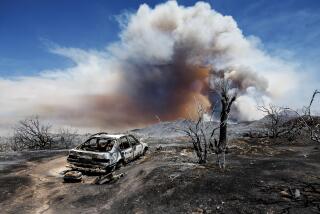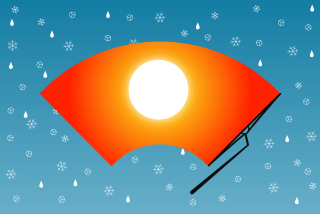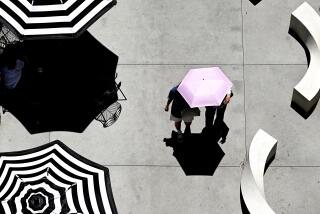A Gray July Goes Out With a Thunderclap : Rain: Unseasonably cool weather ends with an early morning storm that puts on a loud, showy display.
July went out with a flash and a bang early Wednesday as a rare midsummer thunderstorm careened through Southern California, sending weather statisticians to the record books for data to prove what everybody who lives here already knew: July was damp, gray and rotten weather for the beach.
As it turned out, this was the second-wettest July in history at Los Angeles International Airport, according to the National Weather Service. The 0.02 of an inch recorded Wednesday, combined with the 0.15 of an inch recorded July 8, means that more rain fell in the area than in any July since 1886, when 0.24 of an inch was recorded.
According to meteorologist Scott Entrekin at the National Weather Service, the average daily high temperature in Los Angeles was about 78 degrees--about 6 degrees cooler than average for July.
Rare lightning displays startled some Los Angeles-area residents awake around 3 a.m. as thunderstorms left their normal mountain retreats and ventured out into such communities as Silver Lake, Bellflower and Hollywood. In the Hollywood Hills, the thunder was so intense that car alarms were reported set off by the shock of the thunderbolts.
Among the hardest hit areas was San Diego. The storm dropped 0.23 of an inch of rain at Lindbergh Field and knocked out power to about 178,000 utility customers, said John Pruyn, a spokesman for San Diego Gas & Electric Co. Most power was restored by late Wednesday.
“I’ve been here 18 years and I’ve never seen a thunder and lightning storm like this,” Pruyn said.
A flash flood watch was posted for all mountain and desert areas until 8 p.m. Wednesday. Thunderstorms in those areas are more routine this time of year.
Around Los Angeles, the storm took on nostalgic overtones for many residents, reminding people of far more dramatic weather back home--wherever that may have been.
“It reminds me of being a little kid on top of what was called Grandad Bluff in La Crosse, Wis.,” said Jack Schroeder of Huntington Beach.
“All of a sudden, your hair would stand up just prior to a lightning strike, the static causes your hair to stand up. . . .”
John Widmer, a Bellflower toolmaker, said he woke up in the middle of the night when his dog ran into the bedroom, terrified of the lightning and thunder. Widmer said he got up, looked out his window and saw flashes of lightning through a maze of telephone wires.
“It reminded me of growing up in Kansas, looking out over the wheat fields from the front porch at night, seeing the lightning light up the fields,” he said. “Lightning fascinates me. It always has.”
Yet, like many people who live in Southern California, when asked why he moved here, Widmer answered, “the weather.”
Jeff Wright, a self-described “weather nut” who works in a mail room in Brentwood, described Wednesday’s lightning as “a little on the wimpy side.”
Still, he said, “it gives me goose bumps, and considering we haven’t had any since last Aug. 5, it was worth watching.”
“For the first time in campus history, we’ve had two separate measurable rain days,” said James Murakami, meteorologist at the department of atmospheric sciences at UCLA. “Our lightning tends to be the washed out, fuzzy variety . . . but we’ve heard about big bolts of thunder that actually shook up car alarms with this storm.”
Marty Trexler, manager of WeatherData Inc., a private meteorological service that supplies information to The Times, attributed the odd weather pattern to a shifting of the high pressure ridge eastward.
“Normally a high pressure area is centered over the Four Corners area (the intersection of Utah, Colorado, New Mexico and Arizona),” Trexler said. “But this summer, the high has been farther to the east, more over the Central Plains, in the Kansas area. This has allowed weather systems in the Pacific Ocean to drive farther south this summer, trailing cold fronts into Southern California, and bringing showers this summer.”
Normally, he said, the cloudiness and fog would be 100 to 200 miles offshore. Trexler said the high pressure area was shifting westward, and predicted a gradual rise in temperatures during August.
Record Rain
This morning’s storm elevated the month’s total rainfall to 0.17 of an inch--exceeding the mark set in 1969.
* When It Rained:
DATE & INCHES
July 8: .10
July 19: .05
July 31: .02
Total: .17
* Previous Record:
July, 1969: .15
SOURCE: National Weather Service, Weather Data
More to Read
Sign up for Essential California
The most important California stories and recommendations in your inbox every morning.
You may occasionally receive promotional content from the Los Angeles Times.










